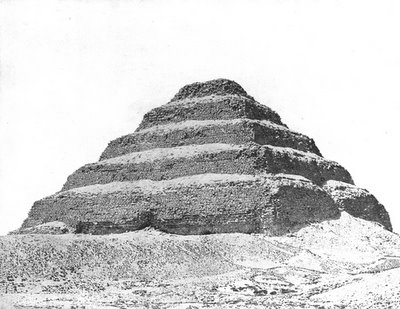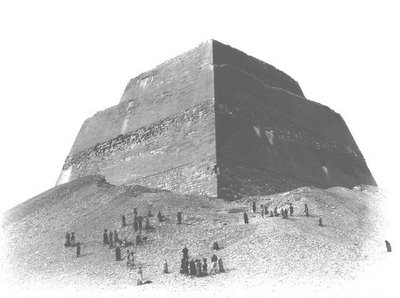Egypt's Other Pyramids Part I: Saqqara and Meidum
Most tourists in Egypt see three pyramids - the well known structures at Giza built by Cheops (Khufu), Chephren (Khafre) and Menkaure (Mycerinus). But Egypt has many other secrets to reveal. A total of about a hundred pyramids have been found and more are being discovered. There are four other pyramids not far from Giza that in their own way are equally as impressive as the famous three.
The first "great" pyramid to be built was the Step Pyramid at Saqqara, located ten miles south of Giza. It is the oldest known dressed stone building in the world, according to the Encyclopedia Britannica. The pyramid sits in an enormous complex that was designed by the architect Imhotep during the rule of Pharaoh Djoser (Zoser) (~ 2675 - 2625 BC) of the third dynasty.
Imhotep was later revered as the greatest architect, physician and wizard in Egyptian history. It is said that he learned his craft by gaining access to the secret writings of earlier ages, perhaps as a result of his position as the High Priest of Heliopolis. His tomb, which has never been found, may hold much information on the origins of Egyptian science.
The Step Pyramid is accompanied by a series of store rooms and a large courtyard, all enclosed within a limestone wall. Much of the stone is carved to resemble the wooden building materials commonly used at the time. The stones are smaller than those used in later pyramids, and this has caused much erosion of the surface.

Djoser's step pyramid at Saqqara
The overall effect of the place is overpowering when seen in person, even though much is in ruins. The sense of a unified artistic concept belies those who claim the structure was built in stages with several revisions of the plan. It is justified that the building of the Step Pyramid is considered to mark the start of the Old Kingdom, the golden age of ancient Egypt.
With the beginning of the Fourth Dynasty, pyramids began to take their more familiar form. The first Pharaoh of the Fourth Dynasty, Snefru (Snofru or Sneferu) (ruled ~ 2575-2550 BC), is believed to have constructed three pyramids, each nearly as large as the Great Pyramid built by his son Cheops.
Snefru's first effort was at Meidum (Medium or Maidoun), forty miles south of Giza. This huge pyramid is today partly collapsed, giving it the popular name of the Broken Pyramid. From the ruins remaining it is not clear if this was intended as a step pyramid or the first true, geometric pyramid with triangular sides.

Snefru's broken pyramid at Meidum
Archaeologists believe that the structure was built too steeply and that it collapsed before it was completed. It is unclear, if it truly fell at this early date, why the stones were not removed to be reused at Dashur or elsewhere and why the ramp used to construct the pyramid (if indeed there was such a ramp) was not abandoned in place.
Schwaller de Lubicz found indications that Egyptian temples were deliberately defaced (canceled out) by the priesthood as the astrological ages progressed and the particular energies that the temples were tuned to became dormant. It is an interesting speculation that this pyramid could have been canceled when its time had elapsed, rather than destroyed by gravity as a result of poor design.
The remaining portion (which seems to be considerably steeper than the parts that fell) gives an interesting insight to the internal structure of a pyramid.
If these words are near the bottom of the page THIS LINK will take you to part II.
The Ascending Passage Directory is an attempt to examine Ancient Egypt in the light of spiritual understanding. It is the companion website of this blog and will explain many points not covered here AscendingPassage.com.
PYMD.com is centered on the pyramids of the Third and Fourth Dynasties, the great age of pyramid building, and on the great mystery of their construction - the largest stone buildings (and the most precise) ever built by man, found at the supposed beginnings of civilization: Pyramid Mysteries and Secrets.
An exploration of the anomalous and unexplained and a search for ancient wisdom worldwide:AncientMystery.info.
HealWeb Directory is an attempt to redefine what it is to be human, as a part of the greater web of nature:HealWeb.com
Beautiful handcrafted jewelry of Nepal and Tibet can be seen and purchased at: JewelryTibet.com. - A selection including lots directed to both wholesale and retail buyers (still at wholesale prices) is at: AccentNepal.com - an Ebay hosted store that has set prices, not auctions:
The first "great" pyramid to be built was the Step Pyramid at Saqqara, located ten miles south of Giza. It is the oldest known dressed stone building in the world, according to the Encyclopedia Britannica. The pyramid sits in an enormous complex that was designed by the architect Imhotep during the rule of Pharaoh Djoser (Zoser) (~ 2675 - 2625 BC) of the third dynasty.
Imhotep was later revered as the greatest architect, physician and wizard in Egyptian history. It is said that he learned his craft by gaining access to the secret writings of earlier ages, perhaps as a result of his position as the High Priest of Heliopolis. His tomb, which has never been found, may hold much information on the origins of Egyptian science.
The Step Pyramid is accompanied by a series of store rooms and a large courtyard, all enclosed within a limestone wall. Much of the stone is carved to resemble the wooden building materials commonly used at the time. The stones are smaller than those used in later pyramids, and this has caused much erosion of the surface.

The overall effect of the place is overpowering when seen in person, even though much is in ruins. The sense of a unified artistic concept belies those who claim the structure was built in stages with several revisions of the plan. It is justified that the building of the Step Pyramid is considered to mark the start of the Old Kingdom, the golden age of ancient Egypt.
With the beginning of the Fourth Dynasty, pyramids began to take their more familiar form. The first Pharaoh of the Fourth Dynasty, Snefru (Snofru or Sneferu) (ruled ~ 2575-2550 BC), is believed to have constructed three pyramids, each nearly as large as the Great Pyramid built by his son Cheops.
Snefru's first effort was at Meidum (Medium or Maidoun), forty miles south of Giza. This huge pyramid is today partly collapsed, giving it the popular name of the Broken Pyramid. From the ruins remaining it is not clear if this was intended as a step pyramid or the first true, geometric pyramid with triangular sides.

Archaeologists believe that the structure was built too steeply and that it collapsed before it was completed. It is unclear, if it truly fell at this early date, why the stones were not removed to be reused at Dashur or elsewhere and why the ramp used to construct the pyramid (if indeed there was such a ramp) was not abandoned in place.
Schwaller de Lubicz found indications that Egyptian temples were deliberately defaced (canceled out) by the priesthood as the astrological ages progressed and the particular energies that the temples were tuned to became dormant. It is an interesting speculation that this pyramid could have been canceled when its time had elapsed, rather than destroyed by gravity as a result of poor design.
The remaining portion (which seems to be considerably steeper than the parts that fell) gives an interesting insight to the internal structure of a pyramid.
If these words are near the bottom of the page THIS LINK will take you to part II.
The Ascending Passage Directory is an attempt to examine Ancient Egypt in the light of spiritual understanding. It is the companion website of this blog and will explain many points not covered here
PYMD.com is centered on the pyramids of the Third and Fourth Dynasties, the great age of pyramid building, and on the great mystery of their construction - the largest stone buildings (and the most precise) ever built by man, found at the supposed beginnings of civilization:
An exploration of the anomalous and unexplained and a search for ancient wisdom worldwide:
HealWeb Directory is an attempt to redefine what it is to be human, as a part of the greater web of nature:
Beautiful handcrafted jewelry of Nepal and Tibet can be seen and purchased at:
Labels: Egyptian Mysteries, Egyptian Pyramids, Meidum, Saqqara
0 Comments:
Post a Comment
<< Home